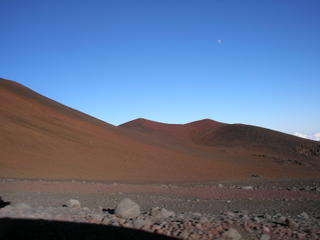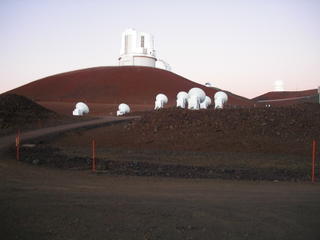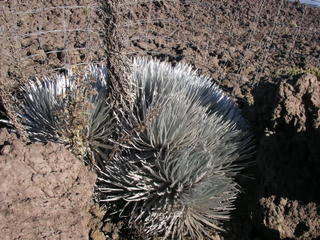Hilo on Hawaii (the big island)
But then, I wasn't there for most of the week. I got to go to Hilo to visit our long time friends, Mac and Lisa. Mac works at the Hahvard radio telescope on Moana Kea. He's also an avid natural phenomonen watcher, so we had to go hike on the the new volcano in search of some hot lava. Alas, we didn't get to burn a stick on hot lava, but we did see some amazing fireworks where it's falling into the ocean. I wore out my knees hiking across a black lava field under a half moon. Ah well, my poor trashed knees are keeping me from weeding garlic at the moment, so all's well that ends.
The trip up to the observatory was another amazing adventure.
 At 13000 and some odd feet, it's the highest I've ever been without a pressurized cabin. It's also about as high as you can go for any length of time without oxygen. It's generally considered to be the top of the troposphere, with only 6/10 of the oxygen we have at sea level. There isn't very much left above you at 13000 feet, which is, of course, the point of being there. The radio telescope measures "tau" in mm of water in the column above them. A low measurement is in microns of water. Typically it's in the mm to cm range. That low water content is only partially due to the altitude. The mountain itself, being largely volcanic cinders doesnm't hold moisture or heat very well. As it cools, it tends to suck the stratosphere down to it's level. It's very windy and cold at night up there, typical temps near 0 even in summer. In fact it looks prety much like Mars from about 11000 feet up. Watching the sunset, it's pretty obvious most of the atmosphere is below you. Truly an awesome and alien place.
At 13000 and some odd feet, it's the highest I've ever been without a pressurized cabin. It's also about as high as you can go for any length of time without oxygen. It's generally considered to be the top of the troposphere, with only 6/10 of the oxygen we have at sea level. There isn't very much left above you at 13000 feet, which is, of course, the point of being there. The radio telescope measures "tau" in mm of water in the column above them. A low measurement is in microns of water. Typically it's in the mm to cm range. That low water content is only partially due to the altitude. The mountain itself, being largely volcanic cinders doesnm't hold moisture or heat very well. As it cools, it tends to suck the stratosphere down to it's level. It's very windy and cold at night up there, typical temps near 0 even in summer. In fact it looks prety much like Mars from about 11000 feet up. Watching the sunset, it's pretty obvious most of the atmosphere is below you. Truly an awesome and alien place.Then there's the observatory.
 They have 7 or 8 radio scopes, each weighing 60000 lb. They get placed on pads around their part of the mountain, enabling different types of research. The antenna's placement on the pads is accurate to several microns. They then run alignment programs that use the synchronous fiber optic cables to discern positions down to a micron or two. There's lots more. Mac took me on a techie tour but I'm afraid I didn't retain very much. Must have been the lack of O2. It's big, it's expensive, and they can see things way out on the edge of space in the 900 -2GhZ range. Needless to say, no WAPS are allowed on the peak. In fact, Mac had heard a rumor of somebody running a WAP in another building, so we took a sniffer and went for a little tour. Didn't find anything, but he's considering mounting the sniffer (a little battery powered wardriving device) in the focal point of one of their antenna's and looking a little harder. Oh, one other thing - the receiver element is a chip made in Bell labs, who manage to turn out about 100 of these chips year. They run at 4 deg K.
They have 7 or 8 radio scopes, each weighing 60000 lb. They get placed on pads around their part of the mountain, enabling different types of research. The antenna's placement on the pads is accurate to several microns. They then run alignment programs that use the synchronous fiber optic cables to discern positions down to a micron or two. There's lots more. Mac took me on a techie tour but I'm afraid I didn't retain very much. Must have been the lack of O2. It's big, it's expensive, and they can see things way out on the edge of space in the 900 -2GhZ range. Needless to say, no WAPS are allowed on the peak. In fact, Mac had heard a rumor of somebody running a WAP in another building, so we took a sniffer and went for a little tour. Didn't find anything, but he's considering mounting the sniffer (a little battery powered wardriving device) in the focal point of one of their antenna's and looking a little harder. Oh, one other thing - the receiver element is a chip made in Bell labs, who manage to turn out about 100 of these chips year. They run at 4 deg K. Yes, this is silversword, one of only a few hundred such plants. They only grow on the upper reaches of the big island.
Yes, this is silversword, one of only a few hundred such plants. They only grow on the upper reaches of the big island.Many thank you's and aloha's to Mac and Lisa for their hospitality and guided tours of truly unique territory.


0 Comments:
Post a Comment
<< Home